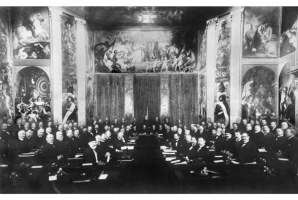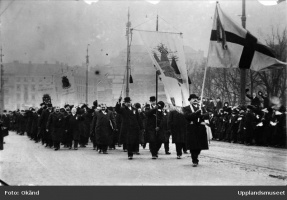Neutrality and Limited Warfare, 1815-1914↑
Neutrality as it existed in 1914 was shaped first and foremost by its evolution during the “long” 19th century. Recognised as a valuable tool of statecraft by great and small powers alike, neutrality – as old as war itself – was redefined primarily as a set of international legal statutes that bound states to behave in certain ways, thereby regulating the conduct between belligerents and non-belligerents in time of war. It was adopted by states wishing to avoid involvement in costly and unnecessary wars, but also had systemic properties: it ensured European and global stability by limiting wars in scale and scope, and by protecting the increasingly vital connections between the European states and their (imperial) markets and supplies. The First World War and its “totalizing logic”, however, robbed neutrality of its systemic value, resulting in enormous pressures being exerted by the warring great powers on (smaller) states that opted for neutrality.[1] However, neutrality managed to retain some of its value – both for belligerents and the neutrals themselves – for strategic, political, economic and cultural reasons.
In 1914, a comprehensive, but by no means complete or undisputed body of international law was created which defined the neutral states' parameters of action. It consisted of neutral rights and neutral duties formalised by international agreements such as the 1856 Declaration of Paris and the 1899 and 1907 Hague Conventions. For example, Hague Convention V guaranteed that in wartime the territory of neutral states would be inviolable. This right to territorial integrity also implied a duty to halt belligerent military personnel from traversing neutral territory. Allowing them to pass unhindered would give them a clear military advantage, and would therefore be considered unneutral. The question of what exactly constituted sufficient neutral policing of borders remained an open one, however, illustrating that even during the “golden age” of legal neutrality, its application remained fraught with uncertainties. The system was workable, however, not only because neutrality’s systemic value was widely appreciated, but also because neutrality was never “just” a legal system: it was also shaped by precedence and by national and transnational notions of what a neutral “ought” to do.[2]
Neutrality and Total War, 1914-1918↑
The First World War saw breaches of neutrality on an unprecedented scale. Belligerents invaded neutral territory and assumed “belligerent rights” at sea that infringed upon both the spirit of pre-1914 agreements and decades of precedence. Since the stability of the international system was no longer a concern – rather, both belligerent blocs rephrased their war efforts as a fight to change the world for the better – a state’s neutrality had to serve a practical purpose to the belligerents. Sometimes, these purposes were shared by all belligerents – the Netherlands’ neutrality was made possible, amongst other things, by shared unwillingness to open a new front so close to important German and British population centres – but more often than not they were contradictory. Often, only the (real or perceived) economic benefits and the danger of pushing a neutral into the enemy camp served to limit belligerent pressure, something skilled neutral diplomatists could exploit.[3]
Moreover, in those states that had been permanently neutralised (e.g. Switzerland) or had been long-time neutrals (e.g. the Netherlands and Sweden) a connection between national identity and neutrality had been forged during the 19th century that survived the First World War. Other states remained neutral because it was deemed the least divisive option (e.g. in Spain). These remained in the minority, however. Most states that declared their neutrality at the outbreak of war in July 1914 ended up formally (such as Bulgaria or Romania) or informally declaring sides (such as those countries associated with the Allies or the Central Powers, one example of the latter being Uruguay). Their ruling elites felt that national ambitions could seemingly only be realised through active engagement with the war or a seat at the table at the peace conference that would end it. For example, the unification of all Italians in one state, interventionists successfully argued in early 1915, could only be achieved by forcefully liberating the irredentist territories. And the American government contended in 1917 that it could not tolerate a global order dictated by the German Kaiser; it therefore fought to make sure the peace settlement would be one in accord with American values, interests and ambitions.
Neutrality could also be lost due to belligerent infractions: the sovereignty of Belgium and Albania, for example, were sacrificed simply because the perceived strategic benefits of doing so outweighed the downsides. Only where both a neutral state’s own population and the belligerent powers remained convinced that neutrality’s benefits outweighed belligerency could neutrality survive the First World War.[4] The fact that on 11 November 1918 only a handful of states had remained neutral (in Europe: Norway, Sweden, Denmark, the Netherlands, Switzerland and Spain; in South America: Mexico, Chile and Argentina) suggests that the ability to do so during the First World War was the exception rather than the rule.
In addition to neutral states – and citizens self-identifying as neutral – some international organisations and institutions such as the International Committee of the Red Cross and the Holy See also remained neutral throughout the war. Here, too, continued neutrality was dependent on the combination of the continued utility of their services rendered to the belligerents and their perceived self-interest in continued non-involvement in the conflict.
Samuël Kruizinga, University of Amsterdam
Section Editor: Emmanuel Debruyne
Notes
- ↑ Horne, John: Introduction. Mobilizing for ‘Total War’ 1914-1918, in: Horne, John (ed.): State, Society and Mobilization in Europe during the First World War, Cambridge et al. 1997, pp. 1-18, esp. p. 3f.
- ↑ Neff, Stephen C.: The Rights and Duties of neutrals. A General History, Manchester 2000, pp. 112ff and 136-142; Abbenhuis, Maartje: An Age of Neutrals. Great Power Politics 1815-1914, Cambridge 2014, pp. 1-22.
- ↑ Coogan, John W.: The End of Neutrality. The United States, Britain and Maritime Rights, 1899-1915, Ithaca et al. 1981, pp. 18f, 123f, 135ff, 154-168, 212ff; Osborne, Eric W.: Britain’s Economic Blockade of Germany, 1914-1919, London 2004, pp. 58-63; Lambert, Nicholas A.: Planning Armageddon. British Economic Warfare and the First World War, Cambridge et al. 2012, pp. 185-231.
- ↑ Kruizinga, Samuël: Neutrality, in: Winter, Jay (ed.): The Cambridge History of the First World War, volume II, Cambridge 2014, pp. 542-575; Kruizinga, Samuël: Neutralität, in: Hirschfeld, Gerhard/Krumeich, Gerd/Renz, Irina (eds.): Enzyklopaedie Erster Weltkrieg, volume II, Paderborn 2014, pp. 1052-1056.
Selected Bibliography
- Abbenhuis, Maartje: An age of neutrals. Great power politics, 1815-1914, Cambridge 2014: Cambridge University Press.
- Amersfoort, Herman / Klinkert, Wim (eds.): Small powers in the age of total war, 1900-1940, Leiden 2011: Brill.
- Hertog, Johan den / Kruizinga, Samuël (eds.): Caught in the middle. Neutrals, neutrality and the First World War, Amsterdam 2011: Aksant.
- Nevakivi, Jukka (ed.): Neutrality in history / La neutralité dans l'histoire. Proceedings of the Conference on the History of Neutrality organized in Helsinki 9-12 September 1992 under the auspices of the Commission of History of International Relations, Helsinki 1993: Suomen historiallinen seura.
- Ørvik, Nils: The decline of neutrality 1914-1941. With special reference to the United States and the northern neutrals, London 1971: Frank Cass & Co.
- Schmitt, Hans A. (ed.): Neutral Europe between war and revolution, 1917-23, Charlottesville 1988: University Press of Virginia.












